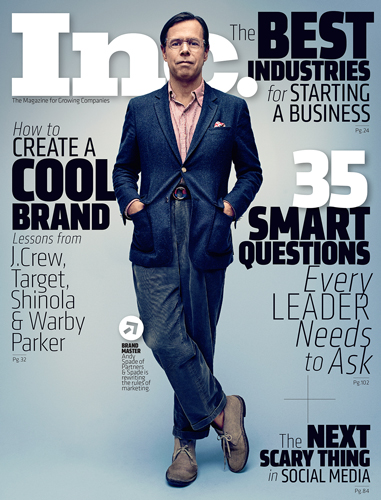10 More Great Questions for Leaders – Which is Your Favorite?
The questions below are an extract of an excellent list compiled by INC Magazine in the April 2014 issue. This is the second post of questions. The first 10 questions can be found in the June 12, 2014 post.
- What prevents me from making the changes I know will make me a more effective leader? Marshall Goldsmith (leadership coach and author)
- What are the implications of this decision 10 minutes, 10 months, and 10 years from now? Suzy Welch (author)
- Do I make eye contact 100 percent of the time? Tom Peters (author and management expert)
- What is the smallest subset of the problem we can usefully solve? Paul Graham (co-founder of Y Combinator)

- Are we changing as fast as the world around us? Gary Hamel (author and management consultant)
- If no one would ever find out about my accomplishments, how would I lead differently? Adam Grand (author and professor at Wharton)
- Which customers can’t participate in our market because they lack skills, wealth or covenient access to existing solutions? Clayton Christensen (author, Harvard Business School Professor)
- Who uses our product in ways we never expected? Kevin R. Coyne and Shawn T. Coyne (authors and strategy consultants)
- How likely is it that a customer would recommend our company to a friend or colleague? Andrew Taylor (executive chairman of Enterprise Holdings)
- Is this an issue for an analysis or intuition? Tom Davenport (author and professor at Bobsen College)
Picture: www.inc.com
The Right Mindset for Transformational Change
A few weeks ago I wrote a post about the “Wrong Mindset for Transformational Change” (May 29, 2014). The article below is its sequel. As mentioned initially, the focus is on the mindset with which to approach the change (…rather than the step-by-step process for defining vision & strategy).
As suggested in the previous post on this topic, if both the “nickel-&-dime-approach” and the “keep-the-organization-on-its-toes-approach” are the wrong perspectives on transformational change, what is the right mindset?
Keeping in mind the tension between anticipating new opportunities versus the fear of disrupting what’s working, the following is a right perspective broken down into two parts. It is actually the “carrot and stick” view of the same theme – the existential question of survival. Let’s first take a look at the carrot, then the stick…:
Carrot – it ensures survival…
An organization that’s not continuously adapting, pivoting and reinventing itself is falling behind. To be clear, this doesn’t mean massive change is always needed company-wide, but it does mean there is a constant watchful eye on risks and opportunities with changes made accordingly – sometimes major and transformational, sometimes minor and incremental.
This stance of “agile change” is especially critical in our fast-paced and volatile world where the margin of error between big success and big failure is slim. This was recently brought home to me in discussion with an angel investor about a local entrepreneur with a very interesting technological innovation for which there was strong expressed customer demand.
A formula for success according to most business gurus, right? No. While many aspects of the business were healthy, the production of his device in Asia could not deliver acceptable quality and he did not change suppliers. The “damage” was done, he could not recover quickly enough – the firm went under.
What’s the lesson to be learned and the carrot to pursue? Making change happen isn’t merely about success or growth, it’s about the very survival of the company. Change is life. Stagnation is death.
Stick – if you don’t, someone else will…
This perspective is actually the flip-side of the perspective above. It’s the understanding that if change can be made to improve on the current model, someone will do it. So, the choice is simple, either the organization will make it, and possibly reap the benefits, or it will let a competitor make the change and run the risk of being left behind.
While it sounds straightforward, let’s remember that the impacts of change, especially on an established (and successful) business, can be massive and disruptive…which is exactly why many leaders can’t bring themselves to pull the trigger.
History is rife with examples of this tragic dilemma. Consider: Kodak rejecting digital photography to protect its film business, Microsoft underestimating the dominance of the internet, Nokia missing the smartphone, IBM initially rejecting the PC in favor of mainframes, Blockbuster holding on to its bricks-n-mortar model of renting movies, etc.
Is the lesson that if you pull the trigger to change, you’ll be wildly successful? No, clearly not…since for each one of these examples, one could likely point to a case where making a change (incorrectly or too early) led to equally disastrous results.
The lesson is that an organization must maintain the aforementioned stance of “agile change” to both ride the right waves and, as importantly, know when to jump back off of them (pivot) if they turn out to be the wrong ones. Missing them completely is the tragedy. It gives competitors an advantage and puts one further behind the survival-, success- and learning- curves.
In summary, there are right and wrong (previous post) perspectives to have on transformational change. While we individually have natural tendencies towards one or the other, or both, this is a good opportunity to take a step back and objectively challenge existing paradigms, and possibly even discover our blind spots.
To make it personal, take a moment to reflect on current or recent changes you’ve confronted…which wrong and right mindsets typically face-off in your organization?
Picture: www.evenabrokenwatch.com





